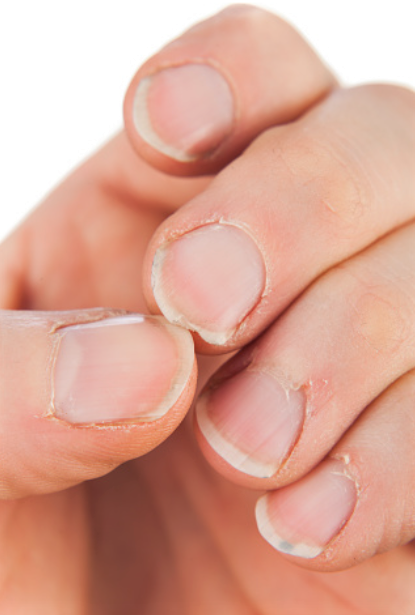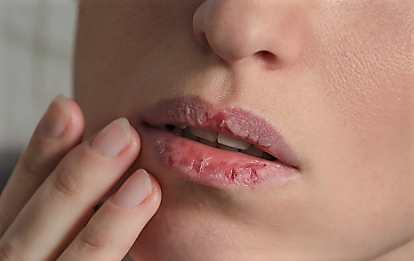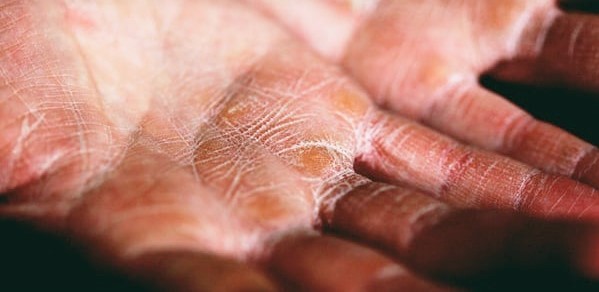The way our hair looks, how our nails grow, the appearance of our skin, the shape of our face, the texture of our tongue, the clarity of our eyesight, and the health of our teeth are ALL influenced by the food we put in our mouths.
So, let’s shed light on the “Nutrition Focused Physical Examination” so that you can recognize the physical signs and symptoms that could be a result of a nutrient deficiency. Nutrient deficiencies can cause serious health problems that cause life-long damage to the body and overall health.
Let’s break this down by system, discuss the symptoms you may observe, and inform you of the possible nutrition-related etiologies.
Let’s start by discussing body composition. If you have unwanted weight loss, loss of muscle mass, or skeletal muscle wasting, it’s usually due to inadequate protein consumption and/or low energy intake. Those who experience these symptoms may also have severe malnutrition. This can occur if someone is trying to figure out their digestive issues—attempting an elimination diet without the proper support. We at Move Fully Nourished, see this ALL the time with clients that come to us asking for help with their digestive discomfort.
SKIN
If you have excess fat stores, poor or delayed healing of wounds or pressure ulcers, dry scaly skin with fine lines and shedding, hyperpigmentation when skin is exposed to sunlight, dermatitis, yellow pigmentation, or eczema—the list of nutrition-related etiologies is long. It could mean your total food intake is excessive, or you are deficient in protein, vitamin C, zinc, essential fat, vitamin A, niacin, tryptophan, iron, folic acid, vitamin B12, or vitamin K just to name a few!
Clients who come to us with changes in their skin often have imbalances due to decreased intake or absorption, increased nutrient requirement, altered utilization, or imbalanced intake of other nutrients.
The skin has its own unique endocrine and immune system and is the organ most distal to the heart. Its nutritional requirements are unique because of the rapid turnover of its’ protective layers. Usually, with nutrition-associated changes, multiple systems are affected. SO, if you see something on your skin, please seek support from a functional dietitian or physician as soon as possible!
NAILS
If your nails are spoon-shaped it can indicate iron deficiency and/or severe malnutrition. If your nails are dull or lackluster it can be from protein or iron deficiency. If your nails are pale, marked with spots or smears, or you have poor blanching (when you push down on your nail bed and it turns white, but it takes longer than 2 seconds for the nail to turn back to pink once released). These signs could indicate dehydration, low blood pressure, or vitamin A or C deficiency. If your nails have ridging it could mean you are deficient in protein.
pressure, or vitamin A or C deficiency. If your nails have ridging it could mean you are deficient in protein.
The nails can be used to monitor toxicity, help evaluate nutrient status, and give insight into systemic imbalances caused by disease. The diet plays a role in the content, strength, shape, and surface of the nail. Adequate mineral intake adds strength and helps with the normal formation of the nail, and vitamins and phytonutrients aid in the oxidative balance of the cuticle and nail bed.
Most nutritional deficiencies will present on the nail before they show up in other clinical or laboratory findings. Even in the case of autoimmune or systemic diseases, symptoms will often show up first as nail changes.
HEAD, SCALP, and HAIR
A scalp that has soft spots is indicative of vitamin D deficiency. Very often we have clients that come to us expressing concern about hair loss. This very noticeable sign could mean something is wrong internally.
If your hair lacks shine or is thinning, it can indicate that you have a protein deficiency, and/or are deficient in zinc, biotin, or linoleic acid. If your hair is easily pluckable this also is related to protein and biotin deficiency. Can you see a theme here? Biotin and protein are big drivers for hair health.
Corkscrew hairs can present anywhere on your body—which literally looks like hair that is bent or coiled—and is due to a vitamin C or copper deficiency.
If you have premature whitening of your hair, it can indicate a selenium or vitamin B12 deficiency. So, it’s clear that protein, biotin, vitamin C, copper, vitamin D, linolenic acid, and zinc are incredibly important for the health of your hair, follicles, and scalp.
FACE
If your face is swollen, or you have varied pigmentation spread across your face, it’s a strong indication of protein deficiency. If your face is very pale it can mean you have an iron, folic acid, or B12 deficiency. If you have a moon face (due to fat deposits on the sides of the face) it’s a strong indication of protein deficiency. Protein deficiency and low energy intake are also etiologies of temporal wasting—observed as indents on either side of the eyes.
EYES
An area of the body where changes are often noticed before skin or nail issues is your eyes. When your conjunctiva (the underside rim of your eyelid that is visible when you pull down your cheek) is pale, it indicates that your body is deficient in iron, folate, and/or B12. It is normal for the inner rim closest to your eye to be lighter in color and the outer rim to be pink or red. However, when the entire inner and outer portion is pale, there is a problem.
your conjunctiva (the underside rim of your eyelid that is visible when you pull down your cheek) is pale, it indicates that your body is deficient in iron, folate, and/or B12. It is normal for the inner rim closest to your eye to be lighter in color and the outer rim to be pink or red. However, when the entire inner and outer portion is pale, there is a problem.
If your eyes are dry, grayish, yellow, or have white foamy spots on the whites of your eyes, it’s a strong indication of vitamin A deficiency. The same goes for a dull, milky, or opaque cornea, or a softening of the cornea, as well as having a very hard time seeing at night—also known as night blindness.
If the corners of your eyes are cracked and reddened it means your body needs riboflavin and/or niacin. Many people know that vitamin A is significant when it comes to eye health, but do you know exactly what food sources to get it from? This is where we really help our clients understand how to tackle their deficiencies head-on from a food-first approach. (*APPLY FOR OUR NUTRITION COACHING PROGRAM HERE*)
MOUTH
There is a strong link between chronic oral inflammation and other health problems. There are over 100 systemic diseases that have oral manifestations, including cardiovascular disease, stroke, respiratory infections, pancreatic cancer, diabetes, and nutritional problems.
A thorough oral examination can identify signs and symptoms of disease that point to clinical imbalances. The problem areas commonly identified include the processes of detoxification, elimination, immune modulation, and energy regulation.
When a person has very red lips or bilateral cracks we check for deficiencies in riboflavin, niacin, pyridoxine, and dehydration. Dehydration is a big one we see in our clients initially. Additionally, a vertical crack in the lips or fissuring (a slit-like opening), can also indicate dehydration, riboflavin, and/or niacin deficiency. If you have very inflamed lips or in your mouth, you could have a low protein, energy, and/or folic acid intake.
Let’s dive deep into the mouth now and talk about the tongue. If your tongue is purplish-red in color or your tongue is inflamed, it is a sign your body needs more vitamin B6, riboflavin, niacin, folate, vitamin B12, or iron. If your tongue is smooth or lacks papillae, (which are the tiny, raised bumps on the tongue that contain taste buds) your body is trying to tell you that you need folate, niacin, riboflavin, iron, vitamin B12, or you are malnourished. If your taste is distorted or decreased, it often indicates a zinc or vitamin A deficiency.
What if you have bleeding gums? Bleeding gums is a sign of vitamin C, riboflavin, folic acid, and/or B12 deficiency.
TEETH
Now we could go on for pages just about teeth health, but let’s highlight a few of the common signs of nutrient deficiencies.
If you are missing teeth, have dental caries, or loose teeth, it can be from excess sugar intake. If your teeth have white or brownish patches, this can be caused by excess fluoride exposure. Fluoride is added to some drinking water and many dental products. However, long-term exposure to high levels can cause a condition called skeletal fluorosis, in which fluoride builds up in the bones.
It is also important to understand that your mouth contains an elimination system that can be altered by oxidative stress, infection, and changes in the coenzyme requirements. This means that mercury amalgams, root canals, implants, periodontal disease, jaw osteonecrosis, nickel-based orthodontic appliances, mixed noble- and base-metal crowns, chrome cobalt partial dentures, BPA-based resin fillings, night guards, and dentures all can create oxidative stress in those who are susceptible.
Now, this isn’t even a complete list of all the physical signs and symptoms of nutritional deficiencies, but we encourage you to examine every part of your body after reading this article!
It is important not to ignore physical signs your body is trying to tell you! If you are concerned about your nutritional health after doing a personal assessment, please seek help! The Move Fully Nourished team can help you navigate through your deficiencies and get you living your best life, feeling fully energized, alert, and able to focus on your health goals.
CLICK HERE to learn more about our self-paced program Replenish and HOW you can uncover the micronutrient deficiencies that are holding you back!
Your Online Dietitian Coach, Ashley Anderson MS, RDN, LDN, CPT, PN1

Your Online Dietitian Coach, Rachel Brown, RD, IBCLC, CDECS, MBA

References:
- Raymond J, Morrow K. Eds. Krause and Mahan’s Food & The Nutrition Care Process, 15th ed. Elsevier, 2021
- Noland D, Driski J, Wagner L, Eds. Integrative and Functional Medical Nutrition Therapy, 1st ed. Humana Press, 2020
- Institute of Functional Medicine: Functional Nutrition Evaluation, Dental Exam Quick Reference Guide, 2016
- Institute of Functional Medicine: Functional Nutrition Evaluation, Nails Exam Quick Reference Guide, 2016
- Institute of Functional Medicine: Functional Nutrition Evaluation, Skin Exam Quick Reference Guide, 2016




